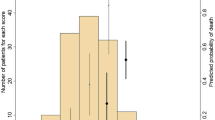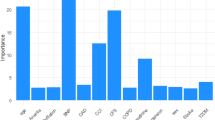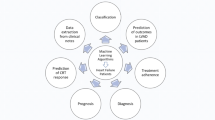Abstract
Objective
Machine learning (ML) algorithm can improve risk prediction because ML can select features and segment continuous variables effectively unbiased. We generated a risk score model for mortality with ML algorithms in East-Asian patients with heart failure (HF).
Methods
From the Korean Acute Heart Failure (KorAHF) registry, we used the data of 3683 patients with 27 continuous and 44 categorical variables. Grouped Lasso algorithm was used for the feature selection, and a novel continuous variable segmentation algorithm which is based on change-point analysis was developed for effectively segmenting the ranges of the continuous variables. Then, a risk score was assigned to each feature reflecting nonlinear relationship between features and survival times, and an integer score of maximum 100 was calculated for each patient.
Results
During 3-year follow-up time, 32.8% patients died. Using grouped Lasso, we identified 15 highly significant independent clinical features. The calculated risk score of each patient ranged between 1 and 71 points with a median of 36 (interquartile range: 27–45). The 3-year survival differed according to the quintiles of the risk score, being 80% and 17% in the 1st and 5th quintile, respectively. In addition, ML risk score had higher AUCs than MAGGIC-HF score to predict 1-year mortality (0.751 vs. 0.711, P < 0.001).
Conclusions
In East-Asian patients with HF, a novel risk score model based on ML and the new continuous variable segmentation algorithm performs better for mortality prediction than conventional prediction models.
Clinical Trial Registration
Unique identifier: INCT01389843 https://clinicaltrials.gov/ct2/show/NCT01389843.




Similar content being viewed by others
Change history
29 November 2021
A Correction to this paper has been published: https://doi.org/10.1007/s00392-021-01947-3
References
Lee SE, Lee HY, Cho HJ, Choe WS, Kim H, Choi JO, Jeon ES, Kim MS, Kim JJ, Hwang KK, Chae SC, Baek SH, Kang SM, Choi DJ, Yoo BS, Kim KH, Park HY, Cho MC, Oh BH (2017) Clinical characteristics and outcome of acute heart failure in Korea: results from the Korean Acute Heart Failure Registry (KorAHF). Korean Circ J 47(3):341–353. https://doi.org/10.4070/kcj.2016.0419
Levy WC, Mozaffarian D, Linker DT, Sutradhar SC, Anker SD, Cropp AB, Anand I, Maggioni A, Burton P, Sullivan MD, Pitt B, Poole-Wilson PA, Mann DL, Packer M (2006) The Seattle Heart Failure Model: prediction of survival in heart failure. Circulation 113(11):1424–1433. https://doi.org/10.1161/CIRCULATIONAHA.105.584102
Pocock SJ, Wang D, Pfeffer MA, Yusuf S, McMurray JJ, Swedberg KB, Ostergren J, Michelson EL, Pieper KS, Granger CB (2006) Predictors of mortality and morbidity in patients with chronic heart failure. Eur Heart J 27(1):65–75. https://doi.org/10.1093/eurheartj/ehi555
O’Connor CM, Hasselblad V, Mehta RH, Tasissa G, Califf RM, Fiuzat M, Rogers JG, Leier CV, Stevenson LW (2010) Triage after hospitalization with advanced heart failure: the ESCAPE (evaluation study of congestive heart failure and pulmonary artery catheterization effectiveness) risk model and discharge score. J Am Coll Cardiol 55(9):872–878. https://doi.org/10.1016/j.jacc.2009.08.083
O’Connor CM, Abraham WT, Albert NM, Clare R, Gattis Stough W, Gheorghiade M, Greenberg BH, Yancy CW, Young JB, Fonarow GC (2008) Predictors of mortality after discharge in patients hospitalized with heart failure: an analysis from the Organized Program to Initiate Lifesaving Treatment in Hospitalized Patients with Heart Failure (OPTIMIZE-HF). Am Heart J 156(4):662–673. https://doi.org/10.1016/j.ahj.2008.04.030
Lee SE, Cho HJ, Lee HY, Yang HM, Choi JO, Jeon ES, Kim MS, Kim JJ, Hwang KK, Chae SC, Seo SM, Baek SH, Kang SM, Oh IY, Choi DJ, Yoo BS, Ahn Y, Park HY, Cho MC, Oh BH (2014) A multicentre cohort study of acute heart failure syndromes in Korea: rationale, design, and interim observations of the Korean Acute Heart Failure (KorAHF) registry. Eur J Heart Fail 16(6):700–708. https://doi.org/10.1002/ejhf.91
Pocock SJ, Ariti CA, McMurray JJ, Maggioni A, Kober L, Squire IB, Swedberg K, Dobson J, Poppe KK, Whalley GA, Doughty RN, Meta-Analysis Global Group in Chronic Heart F (2013) Predicting survival in heart failure: a risk score based on 39,372 patients from 30 studies. Eur Heart J 34(19):1404–1413. https://doi.org/10.1093/eurheartj/ehs337
Sartipy U, Dahlstrom U, Edner M, Lund LH (2014) Predicting survival in heart failure: validation of the MAGGIC heart failure risk score in 51,043 patients from the Swedish heart failure registry. Eur J Heart Fail 16(2):173–179. https://doi.org/10.1111/ejhf.32
Khanam SS, Choi E, Son JW, Lee JW, Youn YJ, Yoon J, Lee SH, Kim JY, Ahn SG, Ahn MS, Kang SM, Baek SH, Jeon ES, Kim JJ, Cho MC, Chae SC, Oh BH, Choi DJ, Yoo BS (2018) Validation of the MAGGIC (Meta-Analysis Global Group in Chronic Heart Failure) heart failure risk score and the effect of adding natriuretic peptide for predicting mortality after discharge in hospitalized patients with heart failure. PLoS ONE 13(11):e0206380. https://doi.org/10.1371/journal.pone.0206380
Johnson KW, Torres Soto J, Glicksberg BS, Shameer K, Miotto R, Ali M, Ashley E, Dudley JT (2018) Artificial Intelligence in Cardiology. J Am Coll Cardiol 71(23):2668–2679. https://doi.org/10.1016/j.jacc.2018.03.521
Shortliffe EH, Sepulveda MJ (2018) Clinical decision support in the era of artificial intelligence. JAMA 320(21):2199–2200. https://doi.org/10.1001/jama.2018.17163
Bühlmann P, Van De Geer S (2011) Statistics for high-dimensional data: methods, theory and applications. Springer Science & Business Media, Berlin
Hanushek EA, Jackson JE (2013) Statistical methods for social scientists. Academic Press, Cambridge
Yuan M, Lin Y (2006) Model selection and estimation in regression with grouped variables. J R Stat Soc Series B (Stat Methodol) 68(1):49–67
Breheny P, Huang J (2009) Penalized methods for bi-level variable selection. Stat Interface 2(3):369
Chen J, Gupta A (2000) Parametric statistical change point analysis (Oberwolfach seminars). Birkhäuser, Basel
Blanche P, Dartigues JF, Jacqmin-Gadda H (2013) Estimating and comparing time-dependent areas under receiver operating characteristic curves for censored event times with competing risks. Stat Med 32(30):5381–5397
Pepe MS, Longton G, Janes H (2009) Estimation and comparison of receiver operating characteristic curves. Stand J 9(1):1–16
Venkatraman E (2000) A permutation test to compare receiver operating characteristic curves. Biometrics 56(4):1134–1138
Venkatraman ES, Begg CB (1996) A distribution-free procedure for comparing receiver operating characteristic curves from a paired experiment. Biometrika 83(4):835–848
Robin X, Turck N, Hainard A, Tiberti N, Lisacek F, Sanchez J-C, Müller M (2011) pROC: an open-source package for R and S+ to analyze and compare ROC curves. BMC Bioinform 12(1):1–8
Adler ED, Voors AA, Klein L, Macheret F, Braun OO, Urey MA, Zhu W, Sama I, Tadel M, Campagnari C (2020) Improving risk prediction in heart failure using machine learning. Eur J Heart Fail 22(1):139–147
Park JJ, Park JB, Park JH, Cho GY (2018) Global longitudinal strain to predict mortality in patients with acute heart failure. J Am Coll Cardiol 71(18):1947–1957. https://doi.org/10.1016/j.jacc.2018.02.064
Kang SH, Park JJ, Choi DJ, Yoon CH, Oh IY, Kang SM, Yoo BS, Jeon ES, Kim JJ, Cho MC, Chae SC, Ryu KH, Oh BH, Kor HFR (2015) Prognostic value of NT-proBNP in heart failure with preserved versus reduced EF. Heart 101(23):1881–1888. https://doi.org/10.1136/heartjnl-2015-307782
Hastie T, Tibshirani R, Friedman J, Franklin J (2005) The elements of statistical learning: data mining, inference and prediction. Math Intell 27(2):83–85
Chen J, Gupta AK (2011) Parametric statistical change point analysis: with applications to genetics, medicine, and finance. Springer Science & Business Media, Berlin
Géron A (2019) Hands-on machine learning with Scikit-learn, Keras, and tensorflow: concepts, tools, and techniques to build intelligent systems. O’Reilly Media, Newton
Zaya M, Phan A, Schwarz ER (2012) Predictors of re-hospitalization in patients with chronic heart failure. World J Cardiol 4(2):23–30. https://doi.org/10.4330/wjc.v4.i2.23
Vivo RP, Krim SR, Liang L, Neely M, Hernandez AF, Eapen ZJ, Peterson ED, Bhatt DL, Heidenreich PA, Yancy CW, Fonarow GC (2014) Short- and long-term rehospitalization and mortality for heart failure in 4 racial/ethnic populations. J Am Heart Assoc 3(5):e001134. https://doi.org/10.1161/JAHA.114.001134
Funding
This work was supported by Research of Korea Centers for Disease Control and Prevention [2010-E63003-00, 2011-E63002-00, 2012-E63005-00, 2013-E63003-00, 2013-E63003-01, 2013-E63003-02, and 2016-ER6303-00]. This work was also supported by the National Research Foundation of Korea [2017R1A5A1015626, 2018R1A2A3075511, 2020R1I1A1A01073151].
Author information
Authors and Affiliations
Corresponding authors
Additional information
The original online version of this article was revised: The Funding section has been revised.
Supplementary Information
Below is the link to the electronic supplementary material.
Rights and permissions
About this article
Cite this article
Kim, W., Park, J.J., Lee, HY. et al. Predicting survival in heart failure: a risk score based on machine-learning and change point algorithm. Clin Res Cardiol 110, 1321–1333 (2021). https://doi.org/10.1007/s00392-021-01870-7
Received:
Accepted:
Published:
Issue Date:
DOI: https://doi.org/10.1007/s00392-021-01870-7




